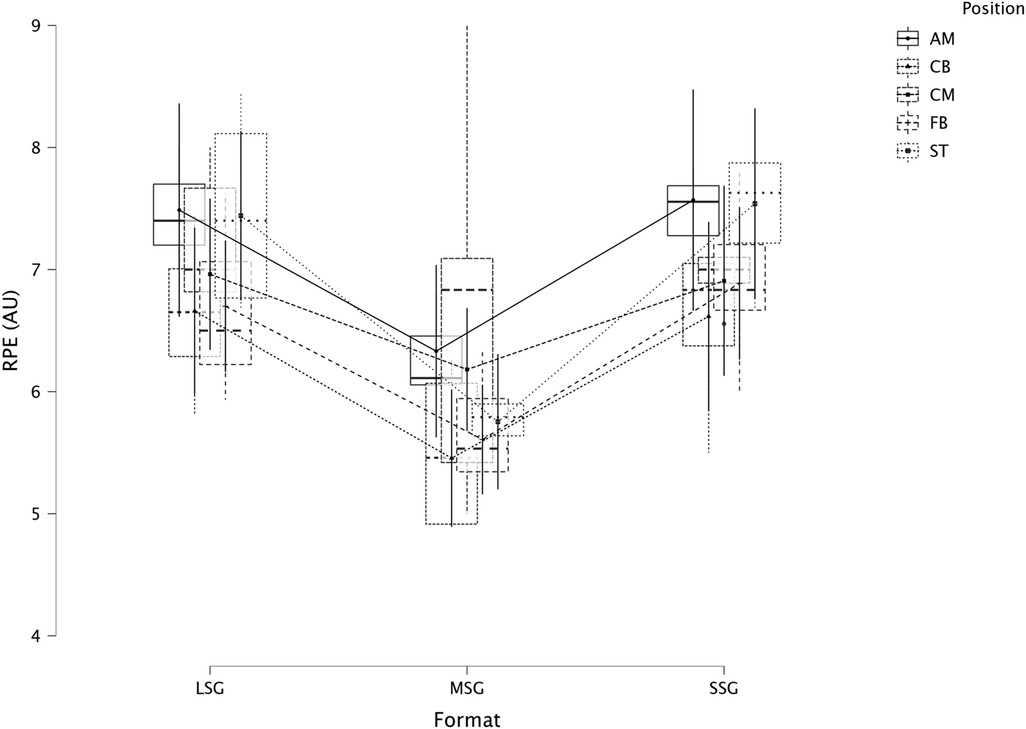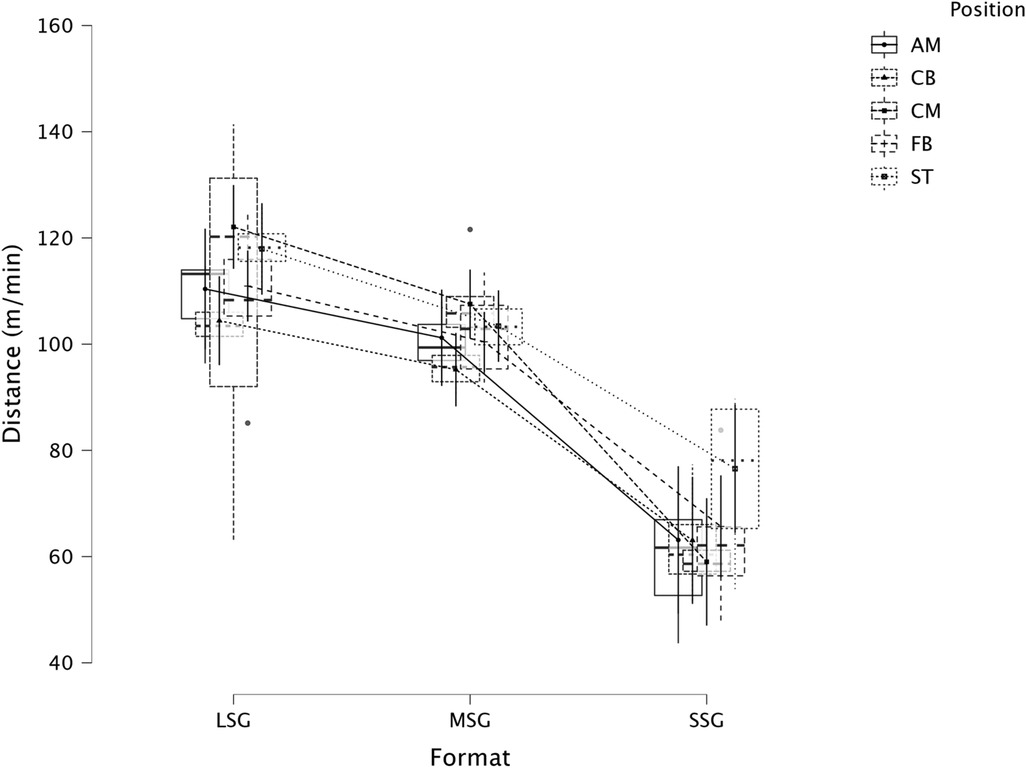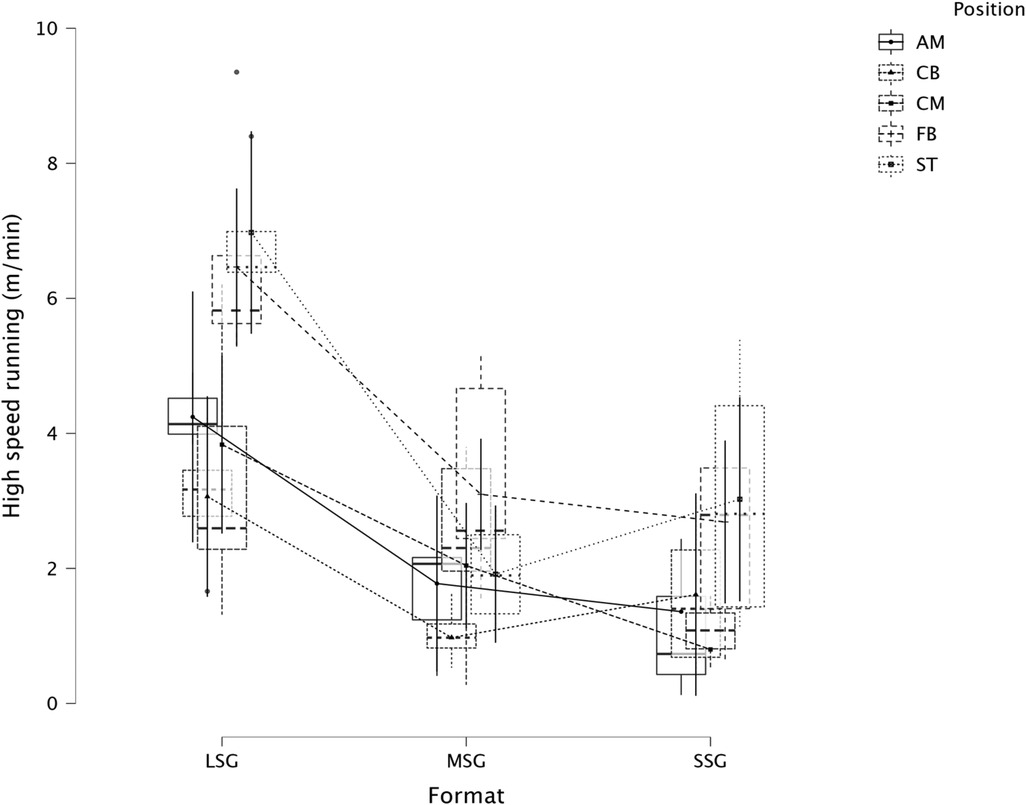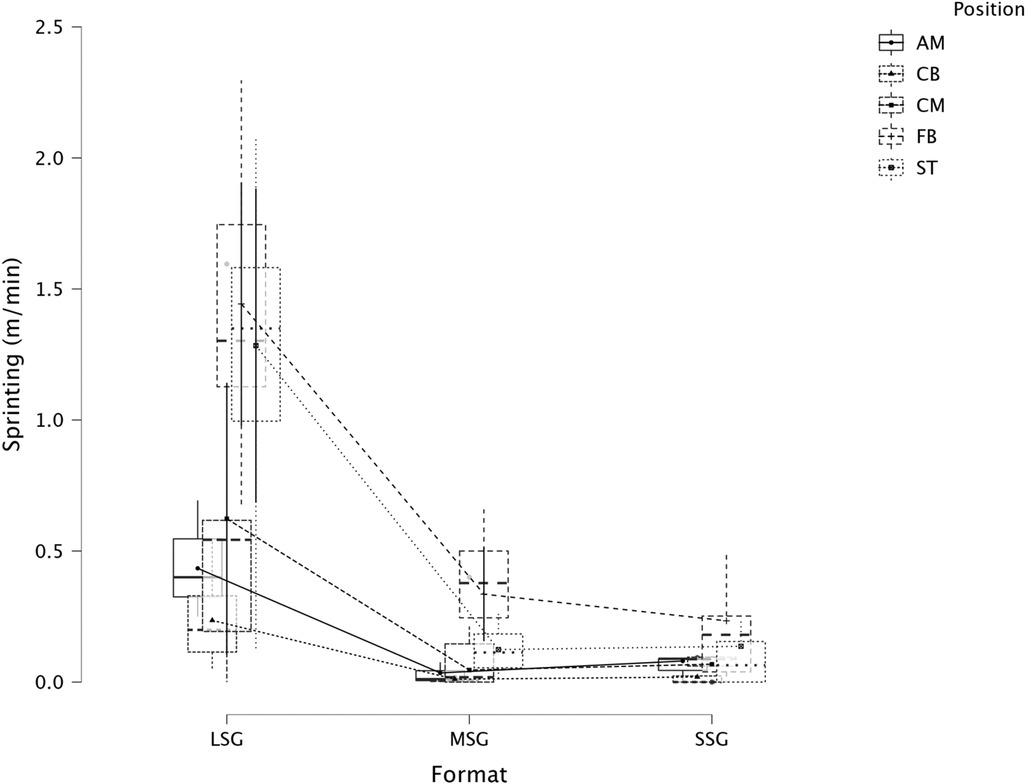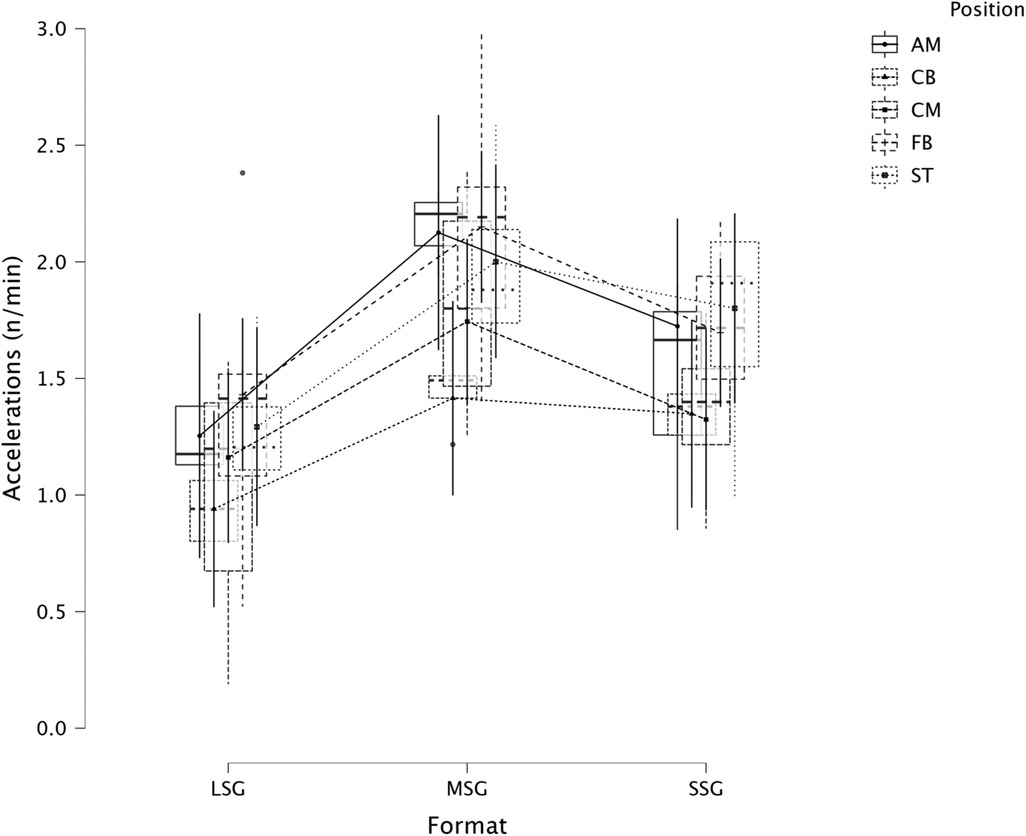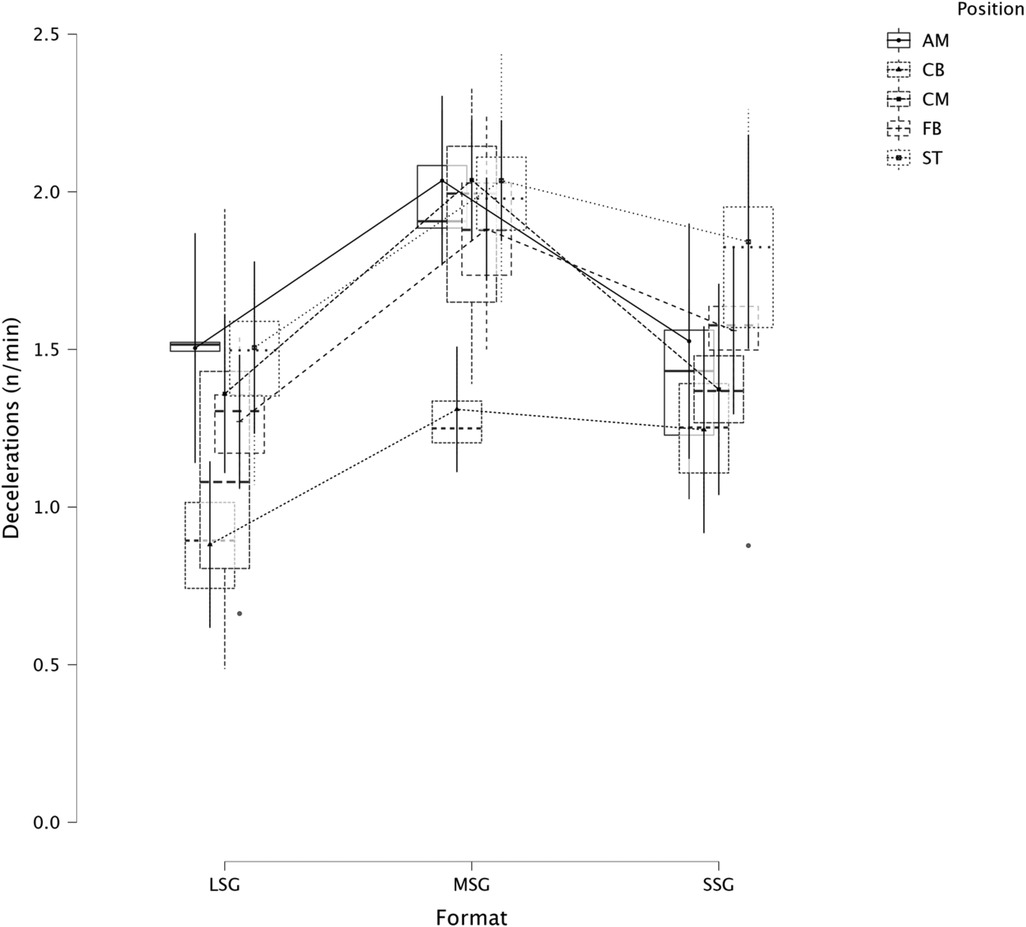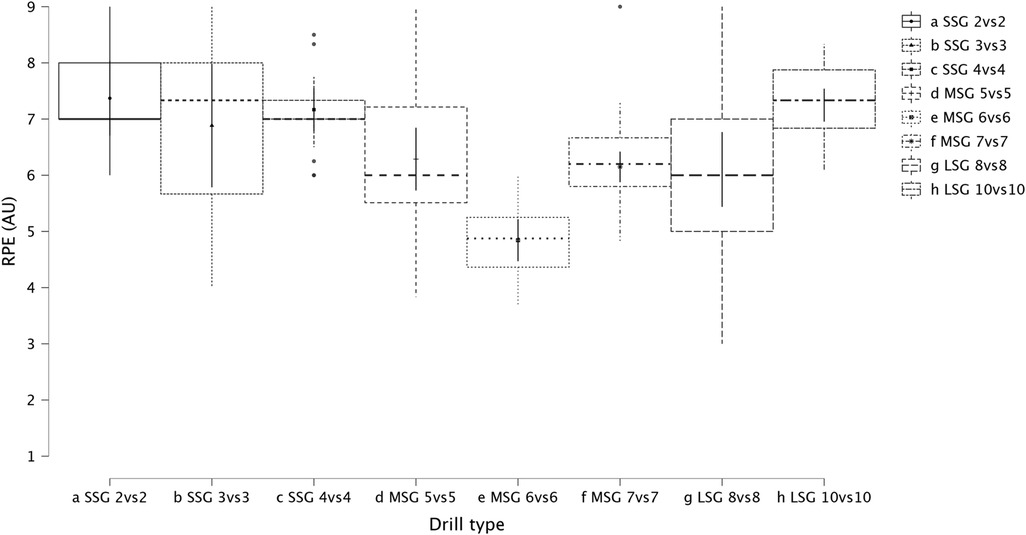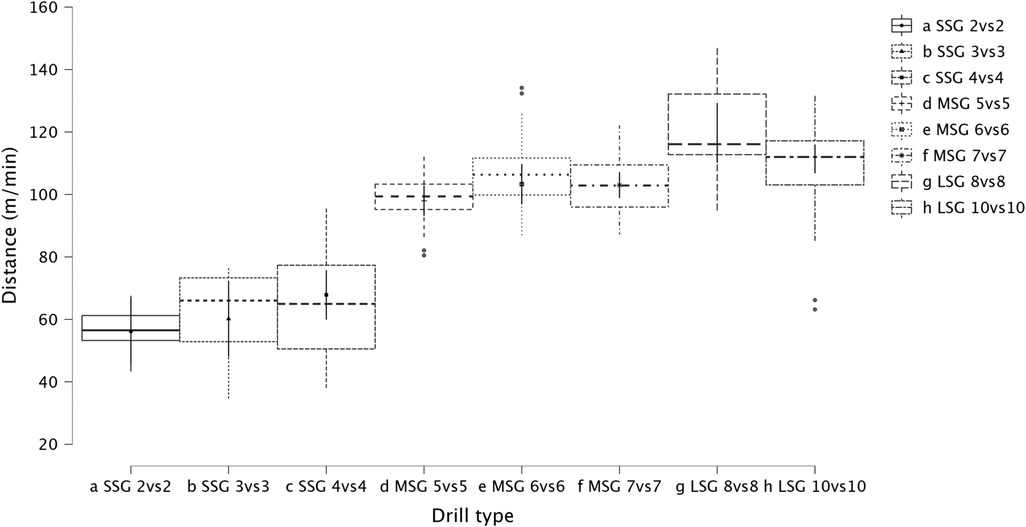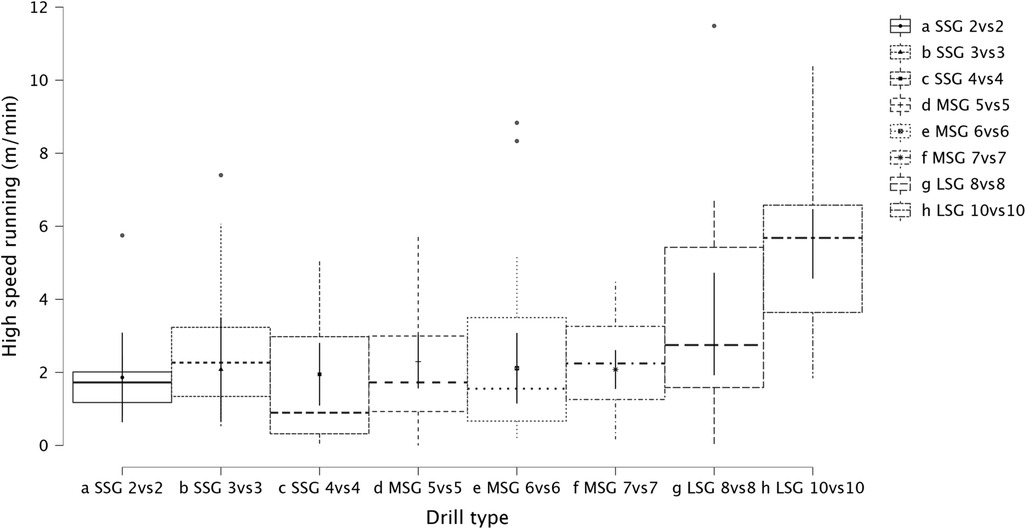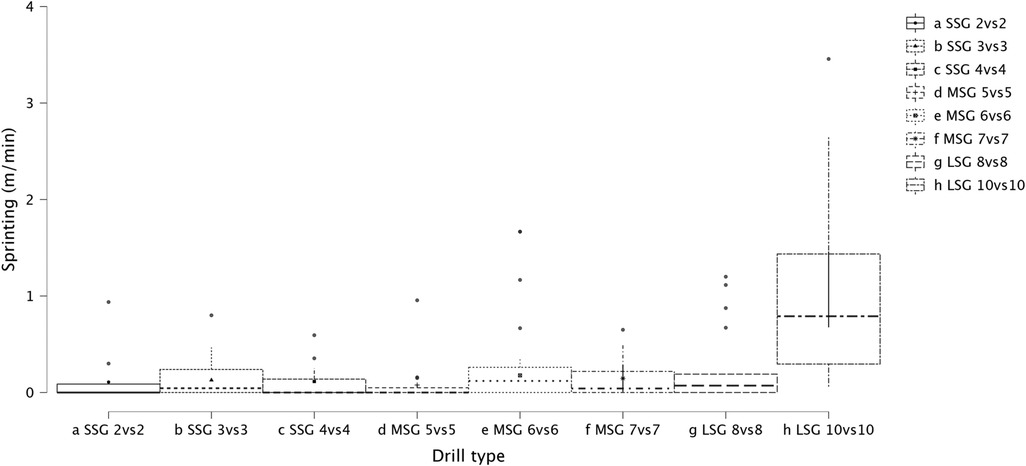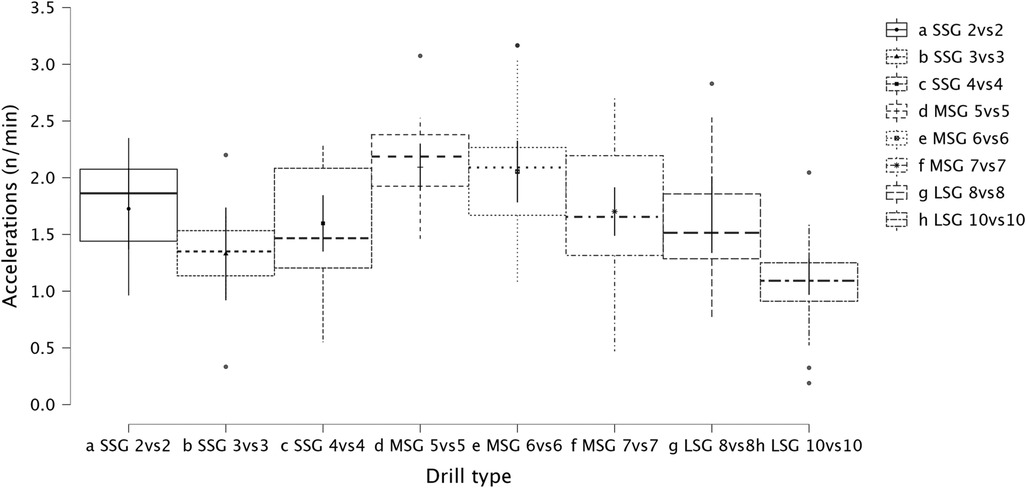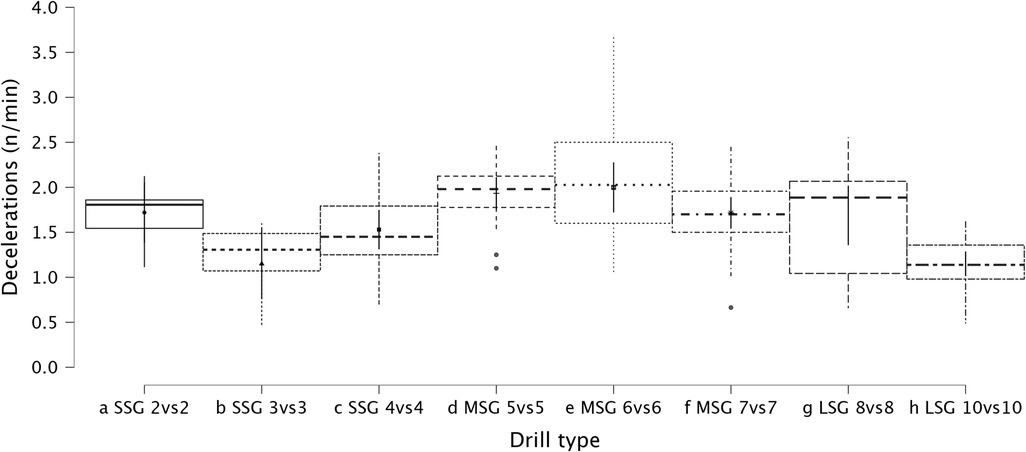Training load comparison between small, medium, and large-sided games in professional football
- 1School of Health and Sports Sciences, University of Suffolk, Ipswich, United Kingdom
- 2Sport and Physical Activity Studies Centre, University of Vic-Central University of Catalonia, Barcelona, Spain
- 3Sport, Exercise, and Human Movement, University of Vic-Central University of Catalonia, Barcelona, Spain
- 4Department of Sport Science, Ipswich Town FC, Ipswich, United Kingdom
This study aimed to assess if internal and external load parameters were different between sided game formats, if players' positions influenced these parameters, and if load parameters were different among sided game types (from 2vs2 to 10vs10) in professional football players. Twenty-five male players of the same club were enrolled in this study (age = 27 ± 9 years and body mass = 78 ± 14 kg). Sided games were categorized in formats as small-sided games (SSG, n = 145), medium-sided games (MSG, n = 431), and large-sided games (LSG, n = 204). Players were divided into roles such as center backs (CB), fullbacks (FB), center midfielders (CM), attacking midfielders (AM), and strikers (ST). STATSports 10 Hz GNSS Apex units were used to monitor external load parameters such as distance, high-speed running (HSR), sprinting distance, accelerations, and decelerations. The linear mixed model analysis found differences between formats (p < 0.001) for the rate of perceived exertion (RPE), distance, HSR, sprinting, accelerations, and decelerations. Differences were found between positions for HSR (p = 0.004), sprinting (p = 0.006), and decelerations (p < 0.001). Moreover, a significant difference was found between sided game types (p < 0.001) for RPE, distance, HSR, sprinting, accelerations, and decelerations. In conclusion, some sided games formats are more suitable for specific load-specific parameters (e.g., distance per minute, HSR, and sprinting are greater during LSG). The number of accelerations and decelerations is higher in MSG compared to other formats. Finally, players' positions influenced external load metrics, specifically HSR and decelerations but not RPE and distance.
Introduction
Football training aims to develop physical capacities, tactical and technical skills to compete during matches (1). In the latest years, sided games, which are categorized as small (SSG), medium (MSG), and large (LSG) formats, have been commonly used by coaches for simultaneously training these capacities and skills (2). Sided games are ball-based drills typically played on smaller pitch areas than regular games, with a fewer players and sometimes using modified rules to achieve specific physical, technical, and tactical aims (3, 4). From a conditioning perspective, sided games can improve aerobic and anaerobic fitness, acceleration and deceleration capacities (4, 5). Still, it has been reported that they may struggle to replicate the high-speed running (HSR) and sprinting demands of football matches (6, 7).
From a training management perspective, previous research found that sided games can be manipulated by changing the pitch sizes on which they are played to obtain a different relative area per player (3, 6). Indeed, HSR increases when larger relative pitch areas are used, while more accelerations and decelerations are performed when smaller relative pitch areas are used (7–10). During a microcycle (1 week) in football, specific sided games are selected and allocated to specific days (e.g., following the principles of tactical periodization) to achieve the desired physical stimuli to the players (11, 12). Sided games are commonly manipulated by changing the number of players involved in the sided games. For instance, SSG format includes 2vs2, 3vs3, and 4vs4, MSG format includes 5vs5, 6vs6, and 7vs7, and LSG formats included 8vs8, 9vs9, and 10vs10 sided games (7). Although a large body of research has investigated different aspects of sided games, we know that acceleration and deceleration demands as well as HSR and sprinting distances are highly variable among studies (7, 10). However, minimal information about thorough analysis from SSG (i.e., 2vs2) to LSG (i.e., 10vs10) within the same football team is available. This could be particularly interesting because it is known that the “one size fits all” approach to sided games actually does not work (13). Furthermore, it is known that players' positions play a role in the external load demands during matches (14). External positions usually require more HSR distance than center defenders or attackers, or in other cases, central positions require a greater number of accelerations and decelerations than external positions (14, 15). This could also be the case for external load demands during sided games, but it is unclear which games allow for different physical demands between positions. Coaches interested in manipulating training demands among positions during their training microcycle should understand these differences.
The quantification of training load is usually categorized into internal and external training load (16, 17). Internal training load is frequently assessed by collecting a player's rating of perceived exertion (RPE) (18, 19). RPE is cheap, easily administered and can capture a player's overall perceived load at the end of drills and sessions (20). Moreover, previous research reported that RPE score is correlated with other physiological measures such as heart rate and blood lactate (18). External training load is commonly monitored using the global navigation satellite system (GNSS) (2, 21, 22). GNSS has been proven to be valid and reliable to assess distance during linear and sport-specific tasks and determining peak speed (21, 23). Moreover, such technology can quantify the number of accelerations and decelerations during drills and sessions, which are critical parameters to consider during the weekly training plan in football (10). Because the difference in internal and external training load between sided games formats as well as the effect of players' positions on such parameters are not clear, a specific study investigating these variables is needed. Therefore, we aimed to verify if internal and external load parameters were different between sided-game formats (SSG, MSG, LSG) and if players' positions influenced these parameters. Finally, we intended to clarify whether internal and external load parameters differed among sided-game types (from 2vs2 to 10vs10) in professional male football players.
Methods
Participants
Twenty-five male professional football players of the same club were enrolled in this study (age = 27 ± 9 years and body mass = 78 ± 14 kg) during the 2022–23 season. The inclusion criteria included the absence of illness and injuries and regular football training and competition participation. Goalkeepers (GKs) were excluded from this study, and only outfield players' match data were evaluated. The sample size estimation was calculated using G*power (Düsseldorf, Germany) for a one-way ANOVA fixed effect that indicated a total of 159 individual data points would be required to detect a small effect (f = 0.25) with 80% power and an alpha of 5%. The actual sample size of this study was 780 individual data points, with a real power of >95%, which reduced the likelihood of type 2 errors (false negative) (24). The Ethics Committee of the University of Suffolk (Ipswich, UK) approved this study (project code: RETHS22/016). Informed consent to take part in this research was signed by the club. The external training load data was recorded as part of the regular monitoring routine of the club and was only analyzed a posteriori. All procedures were conducted according to the Declaration of Helsinki for human studies.
Experimental design
Sided games were categorized in formats such as SSG (n = 145), MSG (n = 431), and LSG (n = 204). SSG included 2vs2, 3vs3, and 4vs4 sided games; MSG included 5vs5, 6vs6, and 7vs7 sided games; LSG included 8vs8 and 10vs10 sided games (7). During these sided games goals were included as well as GKs, football balls around the pitch were available to be used when one ball was kicked off the pitch, and coaches encouraged players to increase intensity. Only players that completed the drill were included in this analysis. Players were divided into positions such as center backs (CB), fullbacks (FB), center midfielders (CM), attacking midfielders (AM), and strikers (ST). The specific number of data points per position is reported in the Supplementary Material.
Sided game type
(a) 2vs2 SSG played with the same rules of a match in restricted spaces, using a medium pitch format, with a relative pitch area of 121 m2.
(b) 3vs3 SSG played using a small pitch format, with a relative pitch area of 72 m2.
(c) 4vs4 SSG played using small and medium pitch formats, with a relative pitch area of 68 m2 and 104 m2, respectively.
(d) 5vs5 MSG played using small and medium pitch formats, with a relative pitch area of 72 m2 and 115 m2, respectively.
(e) 6vs6 MSG played using small and medium pitch formats, with a relative pitch area of 67 m2 and 140 m2, respectively.
(f) 7vs7 MSG played using medium pitch formats, with a relative pitch area of 102 m2 and 144 m2, respectively.
(g) 8vs8 LSG played using a medium pitch format, with a relative pitch area of 157.5 m2.
(h) 10vs10 LSG played using large and regular pitch formats, with a relative pitch area of 229 m2 and 353.4 m2 (108 m × 72 m), respectively.
The specific number of data points per sided game type is reported in the Supplementary Material.
SSG, MSG, and LSG formats were arbitrarily categorized as small pitch size (<99 m2), medium pitch size (from 100 to 199 m2), large pitch size (from 200 to 289 m2), and regular pitch size >290 m2, which is the minimum standard size (100 m × 64 m) of a football pitch for a professional 11-a-side game set by Fédération Internationale de Football Association. In this article, the regular pitch size used was 108 m × 72 m, equivalent to 353.4 m2 per player (including GKs).
Global navigation satellite system (GNSS)
In this study, STATSports 10 Hz GNSS Apex units (Northern Ireland, UK) were used to monitor SSG, MSG, and LSG. GNSS technology tracks multiple satellite systems (i.e., global positioning systems, GLONASS) to provide highly accurate and reliable positional information (21). Moreover, Apex units are integrated with a 100 Hz triaxial accelerometer (25). Before each training session (e.g., 15 min), the GNSS Apex units were turned on to allow the units to track an adequate number of satellites. These units reported the number of satellites tracked that ranged between 17 and 23, which is in line with previous literature (26). All data recorded by the Apex units were downloaded and elaborated by STATSports software (Apex version Sonra v4.4.17) before being exported as a CSV file for further analysis.
Previous research reported the validity and reliability of this technology during linear and soccer-specific tasks reporting an error of <2.5% (21). The reliability (inter-unit) during sprinting actions (range: 5–30 m) was excellent (intra-class correlation coefficient = 0.99), with a typical error of measurement of 1.85% (26).
External and internal load variables
Players' internal load was expressed in arbitrary units (AU) and monitored using a previously validated scale, specifically Borg's CR10. This scale assesses players' rate of perceived exertion (RPE) (18, 27). Each player gave their RPE score after the end of each sided game (28). External load metrics were quantified and reported as frequency per minute to account for the difference in time exposure. In this study, GNSS recorded metrics were distance covered (m·min−1), HSR distance (>19.8 km·h−1), and sprinting distance (>25.2 km·h−1) (8). The number of high-intensity accelerations (>3 m·s−2), and decelerations (<−3 m·s−2) were quantified using GNSS technology (10).
Statistical analyses
Descriptive statistics are reported as mean ± standard deviation (SD). A Shapiro-Wilk test was used to check the assumption that the data conforms to a normal distribution and that the residuals were found normally distributed for the linear mixed model (LMM). The primary analysis was an LMM, which used the Satterthwaite method (degrees of freedom estimation based on analytical results) to assess if significant differences exist between formats (LSG, MSG and SSG; fixed effects) and players' positions (fixed effects) across several dependent variables (29). Players were considered as random effect grouping factors. During the secondary analysis, individual sided games (from 2vs2 to 10vs10, fixed effects) and players (random effects) were analyzed using again a LMM. When significant differences were found in the LMM model, an estimation of marginal means (contrasts) was performed using Holm's corrections for multiple comparisons. Estimates of 95% confidence intervals (CIs) were calculated and reported in the figures (Box Plots). Effect sizes were calculated from the t and df of the contrast and interpreted using Cohen's d principle as follows trivial < 0.2, small 0.2–0.6, moderate 0.6–1.2, large 1.2–2.0, very large > 2.0 (30). Unless otherwise stated significance was set at p < 0.05 for all tests. Statistical analyses were performed in JASP (JASP Version 0.16.13. Amsterdam, Netherlands).
Results
The summary of the comparison between formats (LSG, MSG, and SSG) and positions using a LMM across several dependent variables is reported in Figure 1 (RPE), Figure 2 (distance), Figure 3 (HSR), Figure 4 (sprinting), Figure 5 (accelerations), Figure 6 (decelerations).
LMM analysis for formats (LSG, MSG, and SSG) and positions reported a significant difference between formats (F = 34.3, p < 0.001) but not for positions (p = 0.084) for RPE. LMM analysis reported a significant difference between formats (F = 167.3, p < 0.001) but not for positions (p = 0.119) for distance. LMM analysis reported a significant difference between formats (F = 66.1, p < 0.001) and positions (p = 0.004) for HSR. LMM analysis reported a significant difference between formats (F = 16.4, p < 0.001) and positions (p = 0.006) for sprinting distance. LMM analysis reported a significant difference between formats (F = 47.6, p < 0.001) but not for positions (p = 0.115) for accelerations. LMM analysis reported a significant difference between formats (F = 28.9, p < 0.001) and for positions (p < 0.001) for decelerations.
Summary of the secondary analysis, where individual sided games (from 2vs2 to 10vs10) were analyzed as presented in Figure 7 (RPE), Figure 8 (distance), Figure 9 (HSR), Figure 10 (sprinting), Figure 11 (accelerations), Figure 12 (decelerations). LMM analysis reported a significant difference between sided game types for RPE (F = 28.1, p < 0.001), distance (F = 50.6, p < 0.001), HSR (F = 14.5, p < 0.001), sprinting (F = 4.38, p < 0.001), accelerations (F = 19.8, p < 0.001), and decelerations (F = 14.8, p < 0.001).
The descriptive analysis of sided games formats (LSG, MSG, and SSG), players' positions (CB, FB, CM, AM, and ST), and sided game types (from 2vs2 to 10vs10) is reported in the Supplementary Material.
Estimated marginal means and 95% CIs for sided games formats (LSG, MSG, and SSG), players’ positions (CB, FB, CM, AM, and ST), and sided game types (from 2vs2 to 10vs10) were reported in the Supplementary Material.
Discussion
This study aimed to verify, first, if internal and external load parameters were different between sided-game formats (SSG, MSG, LSG), second, if players' positions influenced these parameters, and finally, if internal and external load parameters were different among sided-game types (from 2vs2 to 10vs10) in professional male football players. We found that internal training load (RPE) changes among sided-game formats. For instance, MSG reported a lower score compared to LSG. External training load parameters are significantly different among formats where, for example, distance per minute is greater during LSG than SSG, and the number of accelerations was greater in MSG than LSG. Players' positions do not affect internal training load among the formats, while they influence some external load parameters; for example, HSR and sprinting distance are greater for ST and FB compared to CB. Finally, both internal and external load parameters were found to be different among sided games (from 2vs2 to 10vs10), where LSG 8vs8 was found to be the most demanding drill for distance covered per minute, and LSG 10 vs. 10 was found to be the most demanding drill for HSR and sprinting. On the other hand, acceleration and deceleration demands were greater in MSG 5vs5 and MSG 6vs6 compared to other formats.
Internal and external load parameters between sided game formats
RPE was found to be significantly (p < 0.001) different between formats (Figure 1). Specifically, RPE in LSG was greater than RPE in MSG (p < 0.001, d = very large) while RPE in SSG was greater (p < 0.001, very large) than in MSG. From a practical perspective, practitioners can use RPE as a cheap monitoring tool for evaluating players' perceived load during sided games (18). However, when RPE is not associated with other external load data, interpreting why these differences between sided games formats exist is quite difficult. In this context, practitioners cannot understand if RPE differences among formats is due, for example, to a greater distance covered or because of a higher number of accelerations performed by the players. Therefore, we suggest practitioners use both internal and external load parameters to have a clearer picture of the demands of their sided game drills (31). Last but not least, RPE is not a pure measure of intensity because it is affected by the duration (of the drill), therefore, practitioners should be conscious of this when they compare drills of different duration. This study analyzed distance covered per minute, one of the most common parameters monitored in football (Figure 2). LSG formats obtained greater distance covered (moderate to very large) than the distance covered during MSG and SSG. While MSG (101.3 m·min−1) reported a significantly greater distance compared to SSG (65.6 m·min−1). Practitioners should preferentially use LSG and MSG when they want to replicate intensities (distance per minute) near match intensity, while SSG are clearly too small to allow for match-specific demands (7, 32). When HSR distance is analyzed, LSG reported a greater distance (5.0 m·min−1, p < 0.001) compared to MSG (2.1 m·min−1) and SSG (2.0 m·min−1). This result is in line with previous research that reported that HSR distance is greater in LSG compared to smaller formats (2, 7). Moreover, previous research reported that LSG are generally suitable to achieve sprinting speed, while smaller formats struggle to do so (8). This is supported by the data of this study, where sprinting distance is exclusively found in LSG (0.9 m·min−1), while MSG and SSG reported distances close to zero (around 0.1 m·min−1). These data confirm that, first, LSG using large spaces (>200 m2 per player) or with regular dimensions (>290 m2) are needed to achieve both HSR and sprinting distances, and second, that players very likely need to perform some running based exercises (e.g., linear sprinting activities) to actually cover an adequate amount of sprinting distance during their microcycle if SSG and MSG are mainly used (8, 33). Practitioners should also consider that matches or their “replication” using regular pitch areas (like in this study, 10vs10 = 353.4 m2) in training can be a potent stimulus for physical development (17, 34). Sided games are also used to generate mechanical and physiological loads in the lower limbs (35, 36); since direct quantification is highly complicated in a football context, practitioners usually quantify accelerations and decelerations (10, 37) using GNSS technology (23, 38). This study found that the number of accelerations is greater in MSG compared to LSG (large) and SSG (small). It is shown that SSG is not the best format for loading (when accelerations are the reference) players, but MSG is. Very similar results were found when decelerations were analyzed; MSG reported a significant (p < 0.001) greater number of decelerations compared with both LSG (large) and SSG (moderate).
Players' positions and internal and external load parameters
In this study, we also analyzed players' positions' effect on internal and external load parameters. RPE and distance covered per minute were not significantly affected by positions, p = 0.084 and p = 0.119, respectively. Therefore, players of different positions can achieve a similar RPE or relative intensity during sided game formats. However, this was not the case when HSR distance was analyzed (Figure 3), specifically, CB (1.9 m·min−1) reported a significantly lower value compared to FB (4.1 m·min−1, p = 0.006) and ST (4.0 m·min−1, p = 0.014), as well as ST covered significantly more HSR than CM (2.2 m·min−1, p = 0.016). This means that coaches can use sided games to stimulate players based on their position. When sprinting distance was analyzed we found a significant difference between positions (p = 0.006, Figure 4), specifically, FB (0.7 m·min−1) outperformed the other positions such as AM (p = 0.025), CB (p = 0.005), and CM (p = 0.025) but they had a similar sprinting distance compared to ST (0.5 m·min−1, p = 0.329). These results highlight that while positions do not affect RPE scores or the distance per minute, they affect HSR and sprinting distance, therefore, coaches and sport scientists should consider this when they are designing their sided game drills during the training microcycle (16). Instead, accelerations were not found to be different among positions (Figure 5, p = 0.115), which means that all players, independently from their role, have similar mechanical demands. However, this was not the case for the number of decelerations recorded (Figure 6), since ST reported the highest number of events (1.8 n·min−1) compared to the other roles such as CB (1.5 n·min−1, p < 0.001) and FB (1.6 n·min−1, p = 0.026). Although these results are interesting and show that sided games' deceleration demands are affected by positions, practitioners should be quite careful because the differences are quite small (see Figure 6). Future research should evaluate if different sided game formats chronically improve some specific physical parameters more than others and if players of different positions actually improve differently.
Internal and external load parameters among sided game types (from 2vs2 to 10vs10)
The secondary analysis of this paper assessed the internal and external load parameters among the sided game types. We found that RPE score was higher in SSG 2vs2 (RPE = 7.4) compared to MSG 5vs5 (RPE = 6.3, p = 0.003), MSG 6vs6 (RPE = 4.8, p < 0.001) and MSG 7vs7 (RPE = 6.1, p < 0.001) but not compared to LSG 10vs10 (RPE = 7.3, p = 0.636). Therefore, coaches should select drills that are very small or very large if they want to increase their players' perceived exertion (Figure 7). However, practitioners should understand that the external load parameters among these drills (SSG 2vs2 and LSG 10vs10) are very different. Therefore, the consequent mechanical and physiological adaptations will also be different although they have similar RPE values. As reported in Figure 8, LSG 10vs10 (111.4 m·min−1) reported the greater distance per minute among sided game types and in particular they have nearly twice the value compared to SSG 2vs2 (56.1 m·min−1). Previous literature reported that professional players of a similar level (English Football League One) covered a distance per minute of 106 m·min−1 during official matches (39). Therefore, all drills above 100 m·min−1 reported in Figure 8 (i.e., MSG 6vs6, MSG 7vs7, LSG 8vs8 and LSG 10vs10) would be suitable to replicate the demands of the match for these players (English League One level). However, the intensity per minute recorded in other leagues is higher than what is reported here, so practitioners should verify that their drills obtain the desired intensity (40, 41). Regarding HSR, LSG10vs10 and LSG 8vs8 (Figure 9) are the most demanding drills, for instance they had a mean intensity of 5.5 m·min−1 and 3.3 m·min−1, respectively, which is largely different (p < 0.001) compared to any SSG formats. Moreover, when the sprinting distance was assessed, LSG10vs10 were the only format which actually reported an intensity greater than 1 m·min−1 (Figure 10). Therefore, LSG10vs10 is the only format that is recommended to be used when coaches want to develop sprinting with their players. However, we should be aware that the overall sprinting dose is limited and may not be sufficient to achieve the aim (2, 17, 33, 42, 43). Contrariwise, regarding accelerations and decelerations, the most suitable drills for training purposes are MSG 5vs5 and MSG 6vs6, respectively (Figures 11, 12). Overall, MSG formats (i.e., 5vs5 and 6vs6) seem to offer a valid acceleration and deceleration frequencies >2 n · min−1. Therefore, coaches and sports scientists could use these sided games to stimulate acceleration and deceleration training doses in their players (10).
Limitations and future directions
This study has some limitations, first, the sample enrolled in this study is a professional team in the English League One; therefore, higher or lower-level players could present different internal and external load demands compared to the ones reported here as well as coaches of other clubs could differently influence these drills with their encouragement. Second, only male players were assessed in this study; therefore, these results should be replicated with female football players to verify that what is reported here can be extended to female populations. Moreover, recent research reported that the use of individualized players' speed thresholds (e.g., sprinting speed or maximal aerobic speed) could be helpful in training load monitoring. An individualization based on the peak speed (e.g., recorded by GNSS) was not performed in this study, therefore, future research could investigate if this approach can offer additional insights (2, 17, 44). Lastly, this study did not consider any metabolic load parameter (e.g., metabolic power) or heart rate (45, 46). Future studies could verify whether these parameters differ among-sided game formats (SSG, MSG, and LSG) or if players' positions influence them.
Conclusions
This study found that internal (i.e., RPE) and external load parameters (e.g., accelerations and sprinting distance) were different between sided-game formats (SSG, MSG, LSG) in professional football players. Some formats were more suitable to load some specific parameters. For instance, distance per minute was greater during LSG than SSG and HSR, and sprinting distance was greater in LSG compared to SSG. This study found that the number of accelerations and decelerations was higher in MSG compared to SSG and LSG, which could have interesting practical applications for coaches. Moreover, this study found that external load metrics (e.g., HSR and decelerations) were subjective to players' positions. For example, HSR and sprinting distance were greater for ST and FB than CB. However, RPE and distance per minute were not affected by positions. Coaches should be aware of the internal load and external load demands of different game formats (LSG, MSG, and SSG), as well as if players' positions can influence these load parameters that would be critical for training load planning. Finally, this study analyzed the internal and external load parameters among sided-game types (from 2vs2 to 10vs10) and found that LSG 8vs8 was the most demanding drill for distance covered per minute, LSG 10 vs. 10 was the most demanding drill for HSR and sprinting. On the other hand, acceleration and deceleration demands were greater in MSG 5vs5 and MSG 6vs6 compared to other formats. Coaches and sports scientists should consider these findings and select the most appropriate sided-game types during their training.
Data availability statement
The raw data supporting the conclusions of this article will be made available by the authors, without undue reservation.
Ethics statement
The Ethics Committee of the University of Suffolk (Ipswich, UK) approved this study (project code: RETHS22/016). The ethics committee waived the requirement of written informed consent for participation.
Author contributions
MB wrote the first draft of the paper and made the first data analysis; AJC recorded the data used in this paper; MB and AJC conceptualized the paper and reviewed the manuscript; JP and JV contributed to the data analysis and reviewed the manuscript. All authors contributed to the article and approved the submitted version.
Acknowledgments
We would like to acknowledge Anna Young's support for this study. Anna helped the authors during data monitoring and during the coding of formats and players as part of the regular monitoring routine of the club.
Conflict of interest
The authors declare that the research was conducted in the absence of any commercial or financial relationships that could be construed as a potential conflict of interest.
Publisher's note
All claims expressed in this article are solely those of the authors and do not necessarily represent those of their affiliated organizations, or those of the publisher, the editors and the reviewers. Any product that may be evaluated in this article, or claim that may be made by its manufacturer, is not guaranteed or endorsed by the publisher.
Supplementary material
The Supplementary Material for this article can be found online at: https://www.frontiersin.org/articles/10.3389/fspor.2023.1165242/full#supplementary-material.
References
1. Bradley PS, Carling C, Gomez Diaz A, Hood P, Barnes C, Ade J, et al. Match performance and physical capacity of players in the top three competitive standards of English professional soccer. Hum Mov Sci. (2013) 32(4):808–21. doi: 10.1016/j.humov.2013.06.002
2. Gualtieri A, Rampinini E, Dello Iacono A, Beato M. High-speed running and sprinting in professional adult soccer: current thresholds definition, match demands and training strategies. A systematic review. Front Sport Act Living. (2023) 5:1116293. doi: 10.3389/fspor.2023.111629
3. Christopher J, Beato M, Hulton AT. Manipulation of exercise to rest ratio within set duration on physical and technical outcomes during small-sided games in elite youth soccer players. Hum Mov Sci. (2016) 48:1–6. doi: 10.1016/j.humov.2016.03.013
4. Kelly DM, Gregson W, Reilly T, Drust B. The development of a soccer-specific training drill for elite-level players. J Strength Cond Res. (2013) 27(4):938–43. doi: 10.1519/JSC.0b013e3182610b7d
5. Moran J, Blagrove RC, Drury B, Fernandes JFT, Paxton K, Chaabene H, et al. Effects of small-sided games vs. conventional endurance training on endurance performance in male youth soccer players: a meta-analytical comparison. Sport Med. (2019) 49(5):731–42. doi: 10.1007/s40279-019-01086-w
6. Hill-Haas SV, Dawson B, Impellizzeri FM, Coutts AJ. Physiology of small-sided games training in football. Sport Med. (2011) 41(3):199–220. doi: 10.2165/11539740-000000000-00000
7. Dello Iacono A, McLaren SJ, Macpherson TW, Beato M, Weston M, Unnithan VB, et al. Quantifying exposure and intra-individual reliability of high-speed and sprint running during sided-games training in soccer players: a systematic review and meta-analysis. Sport Med. (2023) 53(2):371–413. doi: 10.1007/s40279-022-01773-1
8. Beato M, Drust B, Dello Iacono A. Implementing high-speed running and sprinting training in professional soccer. Int J Sports Med. (2021) 42(4):295–9. doi: 10.1055/a-1302-7968
9. Riboli A, Coratella G, Rampichini S, Ce E, Esposito F. Area per player in small-sided games to replicate the external load and estimated physiological match demands in elite soccer players. PLoS ONE. (2020) 15(9):e0229194. doi: 10.1371/journal.pone.0229194
10. Silva H, Nakamura FY, Beato M, Marcelino R. Acceleration and deceleration demands during training sessions in football: a systematic review. Sci Med Footb. (2022):1–16. doi: 10.1080/24733938.2022.2090600
11. Paul DJ, Nassis GP. Testing strength and power in soccer players: the application of conventional and traditional methods of assessment. J Strength Cond Res. (2015) 29(6):1748–58. doi: 10.1519/JSC.0000000000000807
12. Buchheit M, Lacome M, Cholley Y, Simpson BM. Neuromuscular responses to conditioned soccer sessions assessed via GPS-embedded accelerometers: insights into tactical periodization. Int J Sports Physiol Perform. (2018) 13(5):577–83. doi: 10.1123/ijspp.2017-0045
13. Lacome M, Simpson BM, Cholley Y, Lambert P, Buchheit M. Small-sided games in elite soccer: does one size fits all? Int J Sports Physiol Perform. (2018) 13(5):568–76. doi: 10.1123/ijspp.2017-0214
14. Bush M, Barnes C, Archer DT, Hogg B, Bradley PS. Evolution of match performance parameters for various playing positions in the English premier league. Hum Mov Sci. (2015) 39:1–11. doi: 10.1016/j.humov.2014.10.003
15. Bangsbo J, Mohr M, Krustrup P. Physical and metabolic demands of training and match-play in the elite football player. J Sports Sci. (2006) 24(7):665–74. doi: 10.1080/02640410500482529
16. Anderson L, Orme P, Di Michele R, Close GL, Milsom J, Morgans R, et al. Quantification of seasonal-long physical load in soccer players with different starting status from the English premier league: implications for maintaining squad physical fitness. Int J Sports Physiol Perform. (2016) 11(8):1038–46. doi: 10.1123/ijspp.2015-0672
17. Gualtieri A, Rampinini E, Sassi R, Beato M. Workload monitoring in top-level soccer players during congested fixture periods. Int J Sports Med. (2020) 41(10):677–81. doi: 10.1055/a-1171-1865
18. Impellizzeri FM, Rampinini E, Coutts AJ, Sassi A, Marcora SM. Use of RPE-based training load in soccer. Med Sci Sports Exerc. (2004) 36(6):1042–7. doi: 10.1249/01.MSS.0000128199.23901.2F
19. Thorpe RT, Strudwick AJ, Buchheit M, Atkinson G, Drust B, Gregson W. Monitoring fatigue during the in-season competitive phase in elite soccer players. Int J Sports Physiol Perform. (2015) 10(8):958–64. doi: 10.1123/ijspp.2015-0004
20. Scherr J, Wolfarth B, Christle JW, Pressler A, Wagenpfeil S, Halle M. Associations between borg’s rating of perceived exertion and physiological measures of exercise intensity. Eur J Appl Physiol. (2013) 113(1):147–55. doi: 10.1007/s00421-012-2421-x
21. Beato M, Coratella G, Stiff A, Dello Iacono A. The validity and between-unit variability of GNSS units (STATSports Apex 10 and 18 Hz) for measuring distance and peak speed in team sports. Front Physiol. (2018) 9(September):1288. doi: 10.3389/fphys.2018.01288
22. Kelly DM, Strudwick AJ, Atkinson G, Drust B, Gregson W. Quantification of training and match-load distribution across a season in elite English premier league soccer players. Sci Med Footb. (2020) 4(1):59–67. doi: 10.1080/24733938.2019.1651934
23. Beato M, Devereux G, Stiff A. Validity and reliability of global positioning system units (STATSports viper) for measuring distance and peak speed in sports. J Strength Cond Res. (2018) 32(10):2831–7. doi: 10.1519/JSC.0000000000002778
24. Beato M. Recommendations for the design of randomized controlled trials in strength and conditioning. Common design and data interpretation. Front Sport Act Living. (2022) 4:981836. doi: 10.3389/fspor.2022.981836
25. Beato M, De Keijzer KL, Carty B, Connor M. Monitoring fatigue during intermittent exercise with accelerometer-derived metrics. Front Physiol. (2019) 10(June):780. doi: 10.3389/fphys.2019.00780
26. Beato M, De Keijzer KL. The inter-unit and inter-model reliability of GNSS STATSports Apex and Viper units in measuring peak speed over 5, 10, 15, 20 and 30 meters. Biol Sport. (2019) 36(4):317–21. doi: 10.5114/biolsport.2019.88754
27. Impellizzeri FM, Marcora SM, Coutts AJ. Internal and external training load: 15 years on. Int J Sports Physiol Perform. (2019) 14(2):270–3. doi: 10.1123/ijspp.2018-0935
28. Fanchini M, Ferraresi I, Modena R, Schena F, Coutts AJ, Impellizzeri FM. Use of CR100 scale for session rating of perceived exertion in soccer and iis interchangeability with the CR10. Int J Sports Physiol Perform. (2016) 11(3):388–92. doi: 10.1123/ijspp.2015-0273
29. Maullin-Sapey T, Nichols TE. Fisher scoring for crossed factor linear mixed models. Stat Comput. (2021) 31(5):1–25. doi: 10.1007/s11222-021-10026-6
30. Hopkins WG, Marshall SW, Batterham AM, Hanin J. Progressive statistics for studies in sports medicine and exercise science. Med Sci Sports Exerc. (2009) 41(1):3–13. doi: 10.1249/MSS.0b013e31818cb278
31. Thorpe RT, Atkinson G, Drust B, Gregson W. Monitoring fatigue status in elite team-sport athletes: implications for practice. Int J Sports Physiol Perform. (2017) 12:27–34. doi: 10.1123/ijspp.2015-0479
32. Stone NM, Kilding AE. Aerobic conditioning for team sport athletes. Sports Med. (2009) 39(8):615–42. doi: 10.2165/00007256-200939080-00002
33. Kyprianou E, Di Salvo V, Lolli L, Al Haddad H, Villanueva AM, Gregson W, et al. To measure peak velocity in soccer, let the players sprint. J Strength Cond Res. (2022) 36(1):273–6. doi: 10.1519/JSC.0000000000003406. Available at: http://www.ncbi.nlm.nih.gov/pubmed/31800476.31800476
34. Morgans R, Di Michele R, Drust B. Soccer match play as an important component of the power-training stimulus in premier league players. Int J Sports Physiol Perform. (2018) 13(5):665–7. doi: 10.1123/ijspp.2016-0412
35. Zamparo P, Bolomini F, Nardello F, Beato M. Energetics (and kinematics) of short shuttle runs. Eur J Appl Physiol. (2015) 115(9):1985–94. doi: 10.1007/s00421-015-3180-2
36. Zamparo P, Zadro I, Lazzer S, Beato M, Sepulcri L. Energetics of shuttle runs: the effects of distance and change of direction. Int J Sports Physiol Perform. (2014) 9(6):1033–9. doi: 10.1123/ijspp.2013-0258
37. Beato M, Drust B. Acceleration intensity is an important contributor to the external and internal training load demands of repeated sprint exercises in soccer players. Res Sport Med. (2021) 29(1):67–76. doi: 10.1080/15438627.2020.1743993
38. Beato M, Bartolini D, Ghia G, Zamparo P. Accuracy of a 10 Hz GPS unit in measuring shuttle velocity performed at different speeds and distances (5–20 m). J Hum Kinet. (2016) 54(1):15–22. doi: 10.1515/hukin-2016-0031
39. Reynolds J, Connor M, Jamil M, Beato M. Quantifying and comparing the match demands of U18, U23, and 1ST team English professional soccer players. Front Physiol. (2021) 12:706451. doi: 10.3389/fphys.2021.706451
40. Stevens TGA, de Ruiter CJ, Twisk JWR, Savelsbergh GJP, Beek PJ. Quantification of in-season training load relative to match load in professional Dutch eredivisie football players. Sci Med Footb. (2017) 1(2):117–25. doi: 10.1080/24733938.2017.1282163
41. Connor M, Mernagh D, Beato M. Quantifying and modelling the game speed outputs of English championship soccer players. Res Sports Med. (2022) 30(2):169–81. doi: 10.1080/15438627.2021.1888108
42. Mohr M, Krustrup P, Bangsbo J. Match performance of high-standard soccer players with special reference to development of fatigue. J Sports Sci. (2003) 21(7):519–28. doi: 10.1080/0264041031000071182
43. Haugen T, Buchheit M. Sprint running performance monitoring: methodological and practical considerations. Sports Med. (2016) 46(5):641–56. doi: 10.1007/s40279-015-0446-0
44. Filipe A, Clemente M, Ramirez-campillo R, Beato M, Moran J, Kawczynski A, et al. Arbitrary absolute vs. Individualized running speed thresholds in team sports: a scoping review with evidence gap map. Biol Sport. (2023) 40(3):919–43. doi: 10.5114/biolsport.2023.122480
45. Osgnach C, Di Prampero PE. Metabolic power in team sports—part 2: aerobic and anaerobic energy yields. Int J Sports Med. (2018) 39(8):588–95. doi: 10.1055/a-0592-7219
Keywords: soccer, team sports, performance, GPS, monitoring
Citation: Beato M, Vicens-Bordas J, Peña J and Costin AJ (2023) Training load comparison between small, medium, and large-sided games in professional football. Front. Sports Act. Living 5:1165242. doi: 10.3389/fspor.2023.1165242
Received: 13 February 2023; Accepted: 21 April 2023;
Published: 5 May 2023.
Edited by:
Olivier Girard, University of Western Australia, AustraliaReviewed by:
Andrea Fusco, University of Cassino, ItalyBessem Mkaouer, University of Manouba, Tunisia
© 2023 Beato, Vicens-Bordas, Peña and Costin. This is an open-access article distributed under the terms of the Creative Commons Attribution License (CC BY). The use, distribution or reproduction in other forums is permitted, provided the original author(s) and the copyright owner(s) are credited and that the original publication in this journal is cited, in accordance with accepted academic practice. No use, distribution or reproduction is permitted which does not comply with these terms.
*Correspondence: Marco Beato m.beato@uos.ac.uk
 Marco Beato
Marco Beato Jordi Vicens-Bordas
Jordi Vicens-Bordas Javier Peña
Javier Peña Andrew J. Costin
Andrew J. Costin